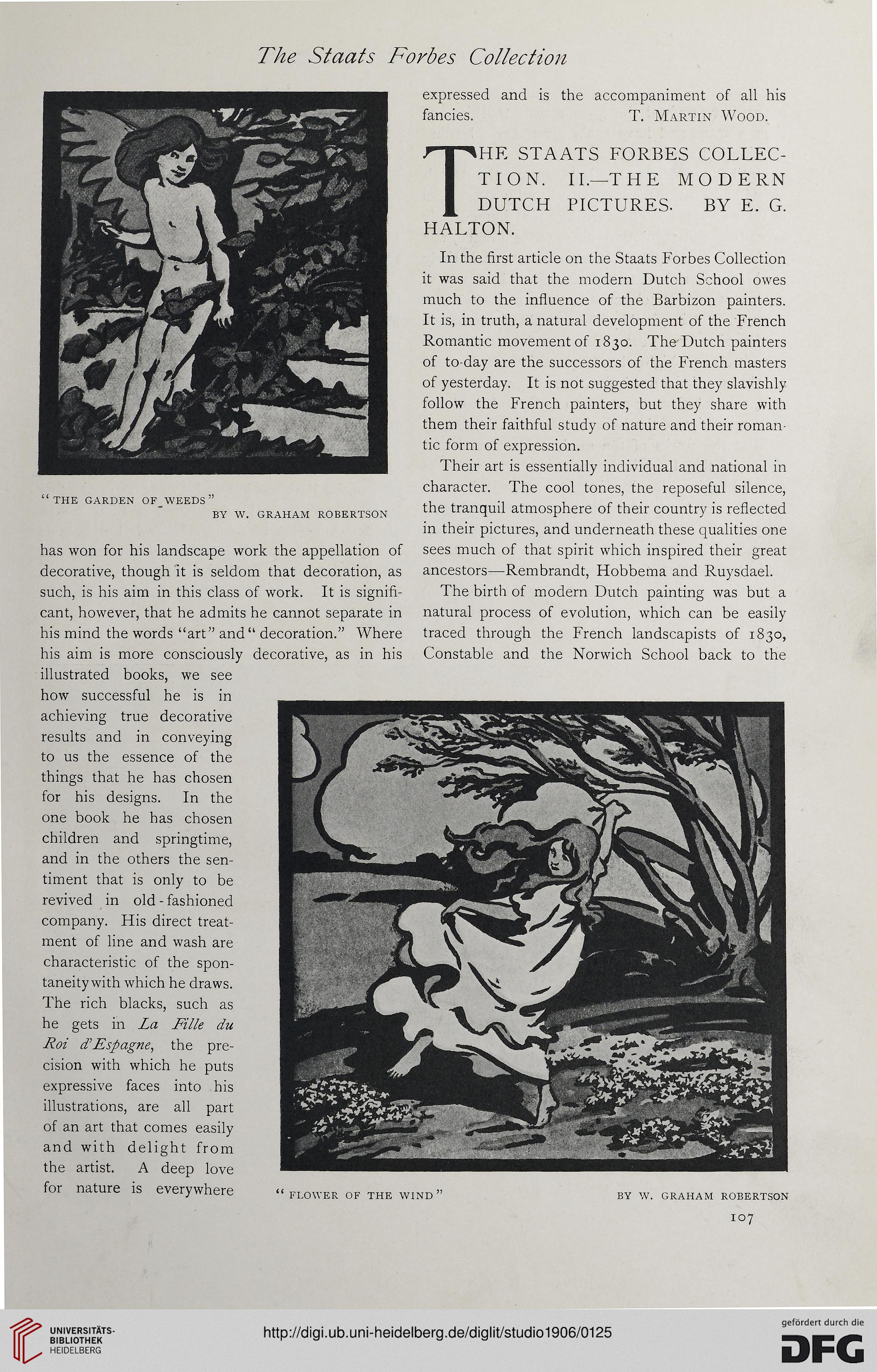The Staats Forbes Collection
expressed and is the accompaniment of all his
fancies. T. Martin Wood.
The staats forbes collec-
TION. II.—THE MODERN
DUTCH PICTURES. BY E. G.
HALTON.
THE GARDEN OF WEEDS'
BY W. GRAHAM ROBERTSON
has won for his landscape work the appellation of
decorative, though it is seldom that decoration, as
such, is his aim in this class of work. It is signifi-
cant, however, that he admits he cannot separate in
his mind the words “art” and“ decoration.” Where
his aim is more consciously decorative, as in his
illustrated books, we see
how successful he is in
achieving true decorative
results and in conveying
to us the essence of the
things that he has chosen
for his designs. In the
one book he has chosen
children and springtime,
and in the others the sen-
timent that is only to be
revived in old - fashioned
company. His direct treat-
ment of line and wash are
characteristic of the spon-
taneity with which he draws.
The rich blacks, such as
he gets in La Fille du
Roi d’Espagne, the pre-
cision with which he puts
expressive faces into his
illustrations, are all part
of an art that comes easily
and with delight from
the artist. A deep love
for nature is everywhere “flower of the wind’
In the first article on the Staats Forbes Collection
it was said that the modern Dutch School owes
much to the influence of the Barbizon painters.
It is, in truth, a natural development of the French
Romantic movement of 1830. The Dutch painters
of to-day are the successors of the French masters
of yesterday. It is not suggested that they slavishly
follow the French painters, but they share with
them their faithful study of nature and their roman-
tic form of expression.
Their art is essentially individual and national in
character. The cool tones, the reposeful silence,
the tranquil atmosphere of their country is reflected
in their pictures, and underneath these qualities one
sees much of that spirit which inspired their great
ancestors—Rembrandt, Hobbema and Ruysdael.
The birth of modern Dutch painting was but a
natural process of evolution, which can be easily
traced through the French landscapists of 1830,
Constable and the Norwich School back to the
BY W. GRAHAM ROBERTSON
expressed and is the accompaniment of all his
fancies. T. Martin Wood.
The staats forbes collec-
TION. II.—THE MODERN
DUTCH PICTURES. BY E. G.
HALTON.
THE GARDEN OF WEEDS'
BY W. GRAHAM ROBERTSON
has won for his landscape work the appellation of
decorative, though it is seldom that decoration, as
such, is his aim in this class of work. It is signifi-
cant, however, that he admits he cannot separate in
his mind the words “art” and“ decoration.” Where
his aim is more consciously decorative, as in his
illustrated books, we see
how successful he is in
achieving true decorative
results and in conveying
to us the essence of the
things that he has chosen
for his designs. In the
one book he has chosen
children and springtime,
and in the others the sen-
timent that is only to be
revived in old - fashioned
company. His direct treat-
ment of line and wash are
characteristic of the spon-
taneity with which he draws.
The rich blacks, such as
he gets in La Fille du
Roi d’Espagne, the pre-
cision with which he puts
expressive faces into his
illustrations, are all part
of an art that comes easily
and with delight from
the artist. A deep love
for nature is everywhere “flower of the wind’
In the first article on the Staats Forbes Collection
it was said that the modern Dutch School owes
much to the influence of the Barbizon painters.
It is, in truth, a natural development of the French
Romantic movement of 1830. The Dutch painters
of to-day are the successors of the French masters
of yesterday. It is not suggested that they slavishly
follow the French painters, but they share with
them their faithful study of nature and their roman-
tic form of expression.
Their art is essentially individual and national in
character. The cool tones, the reposeful silence,
the tranquil atmosphere of their country is reflected
in their pictures, and underneath these qualities one
sees much of that spirit which inspired their great
ancestors—Rembrandt, Hobbema and Ruysdael.
The birth of modern Dutch painting was but a
natural process of evolution, which can be easily
traced through the French landscapists of 1830,
Constable and the Norwich School back to the
BY W. GRAHAM ROBERTSON





